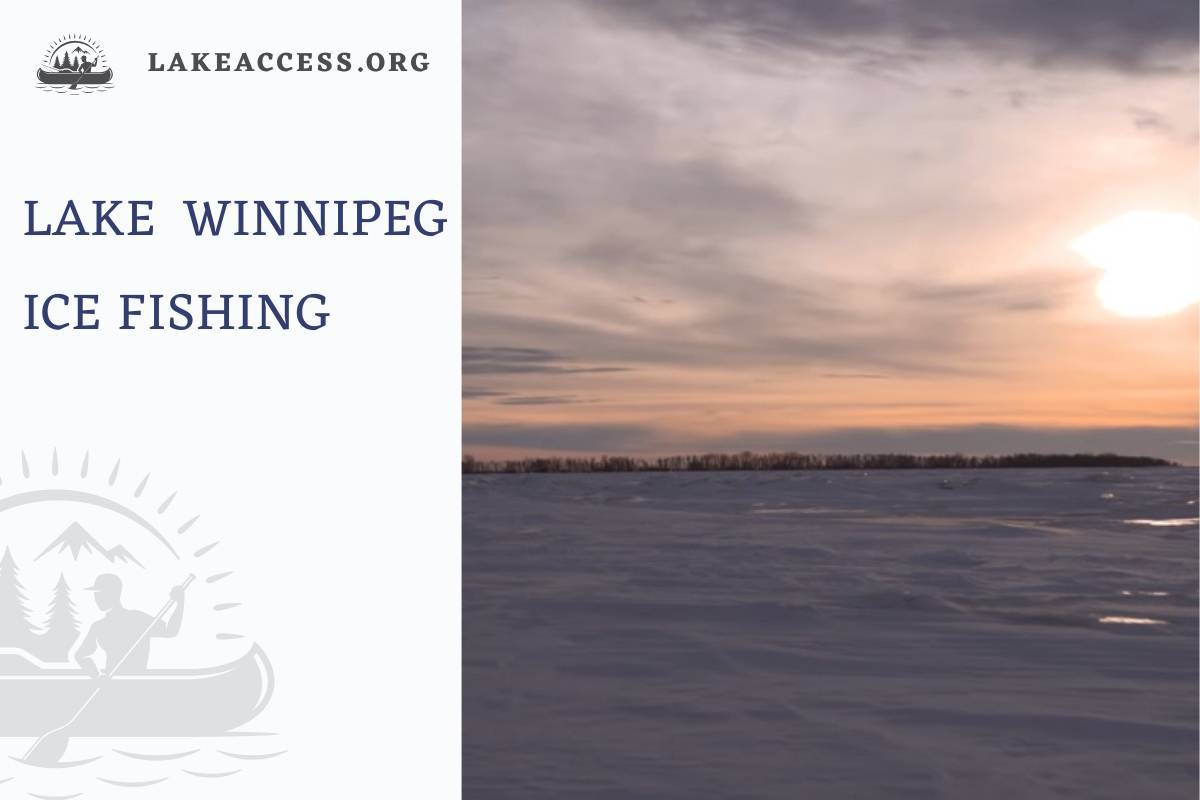Imagine your breath creating miniature clouds as it meets the cold winter air. The vast expanse of Lake Winnipeg, its icy surface twinkling under the soft glow of the sunrise, extends in front of you. This is not your typical fishing trip. You’re standing on the threshold of a unique experience, an epic winter adventure. Known as a paradise for the passionate ice-angler, Lake Winnipeg is a key destination for trophy walleye and an unrivaled ice-fishing adventure.
Lake Winnipeg, located in the heart of Canada, is recognized globally for its ice fishing opportunities. Often regarded as a “Hard Water Heaven”, Lake Winnipeg presents a journey that is as much about embracing the chill as it is about seeking the thrill of fishing. Every year, anglers from around the globe are drawn to this captivating location, enchanted by the promise of catching trophy-size walleye and experiencing the serene beauty of the ice-wrapped landscape. Set to embark on your own unforgettable journey? You’re just at the right place.
Gear Up for Success
For an impressive outing on the icy landscapes of Lake Winnipeg, having the right gear in your hands is vital. This is not just about typical fishing equipment. Ice fishing brings with it a host of unique necessities tailored to facilitate the fishing process amidst the frosty conditions.
Ice Fishing Tools Requisite
First up are the noble instruments of your trophy walleye quest: the ice fishing rods and reels. Specially designed for the rigors of ice fishing, these rods are shorter for ease of handling yet incredibly strong, capable of reeling in the most stubborn of catches. Pair these with a good reel, and you’ve got yourself a formidable walleye-winning combo.
Optimal lure choice can often be the deal-breaker when targeting specific fish species, and it’s no different when the spotlight is on walleye. Effective lures, like jigs and spoons, mimic the movement of the baitfish, resulting in stirring the predator’s instincts. Bright colors that stand out in the cloudy water often tip the scales in favor of successful catches.
Guarding Against the Cold
Successfully enduring a fishing excursion in the subzero temperatures of a Canadian winter requires more than just regular thermal clothing. Having a shelter to retreat into when the weather gets harsh will enhance your overall ice-fishing experience. These can range from simple windbreaks for the resilient souls who love the cold to fully insulated havens equipped with all sorts of modern facilities for those who prefer comfort in their adventure.
Staying warm inside these shelters is also crucial. Heaters become an indispensable part of your gear, not just for you but also for your equipment. A high-quality heater can stop your fishing line from freezing—trust us, a frozen line is the last thing you wish for when you’ve hooked a large walleye.
Focus on Safety
While ice fishing on Lake Winnipeg is an exciting adventure, it’s vital to highlight the importance of safety. Being equipped with safety tools such as ice picks and life jackets is crucial – they aren’t just optional add-ons; consider them essential parts of your gear. Ice picks provide you the required grip to pull yourself out of the water if you, unfortunately, fall in. And a good quality, well-fitting lifejacket can help you stay afloat long enough until help arrives.
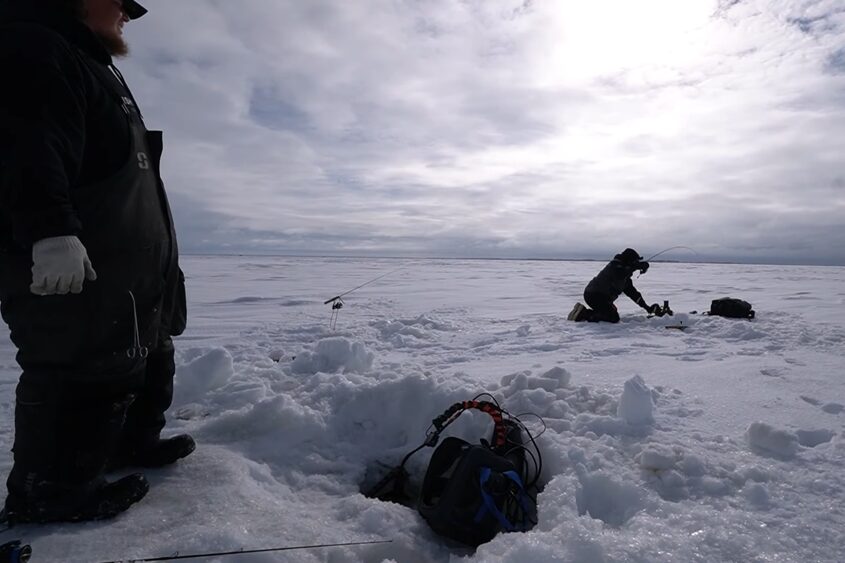
Deciphering Lake Winnipeg’s Ice Fishing Calendar
Ice fishing isn’t a walk-in anytime kind of activity. It requires careful timing, syncing with nature’s rhythms, and of course, a solid understanding of the ever-changing Canadian weather. The thickness of the ice, the migration patterns of the walleye, and the weather conditions all play a significant role in determining your ice fishing calendar.
Ice Thickness & Safety
What is ice fishing without ice, right? That’s the foundation of your adventure, and its thickness is critical. While four inches of ice is considered generally safe for ice fishing, Lake Winnipeg often boasts much thicker ice, particularly during the winter months. However, local fluctuation due to currents, springs, and the like means ice thickness can differ greatly even short distances apart. It’s prudent to continuously check the ice thickness as you venture out. Remember, your safety is a priority!
Walleye Migration Pattern
Despite a shroud of snow and ice beneath the surface, life is teeming in Lake Winnipeg. One key spectacle of wildlife activity you’d be particularly interested in is the migration of walleye. Take a peek beneath the white expanse, and you’ll see walleye scurrying about, adapting to their winter haunts. As temperatures drop, they move deeper in search of food. Trying to predict their movement can be a fascinating, intricate dance that would invigorate even a seasoned angler.
Weather Considerations
The weather in Lake Winnipeg is notorious for its rapid changes. Gnawing cold winds in the morning can quickly swoop away, giving way to a pleasant afternoon. This unpredictable weather plays a vital role in planning your trip. It’s essential to keep in tune with local weather forecasts to make your ice fishing escapade safe and worthwhile.
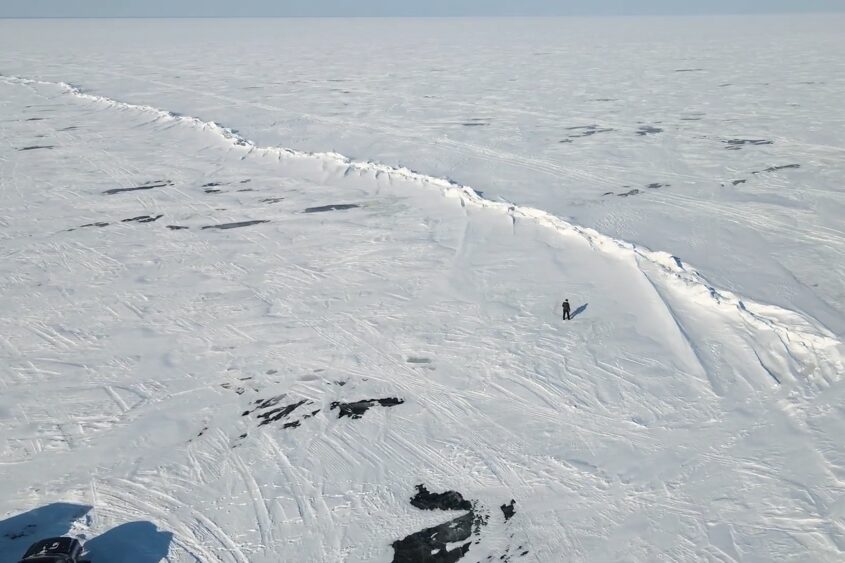
Unveiling Lake Winnipeg’s Prime Fishing Holes
Lake Winnipeg, with its wide area and diverse underwater topography, is home to numerous coveted fishing spots. But knowing where to poke a hole in the vast frozen spread is a challenging task. Moreover, ‘prime fishing locations’ don’t just refer to geographical points; they’re all about where the walleye are, their ‘hot spots’.
Topographical Hotspots
Walleye love structures. Be it humps, reefs, or drop-offs, these underwater features act as mass attractors of walleye. As shadows and cover they provide play critical roles in the walleye’s quest for prey, anglers, too, find them as mines of prospective catches. But remember, unrestrained exploration can expose hidden dangers. Heed the advice of experienced local guides and authorities.
Prosperous River Mouths & Channels
River mouths and channels are another class of locations you might want to mark on your map. These areas act as conduits for food, turning them into a grand theatre of wildlife activity. Walleye, always on the prowl for their next snack, usually hang around these locations. Drilling your fishing hole here might reward you with a big catch.
Baitfish Havens
Alongside walleye, Lake Winnipeg is a favorite haunt for several baitfish species, turning certain areas of the lake into buffet zones. Walleye are one of the apex predators here, and they like to follow their meal. While there’s no fixed formula to determine such zones, an educated guess of congregations of emerald shiners, tulibee, and perch could decide the tale between an ‘alright’ and an ‘awesome’ fishing adventure.
Most targeted fish species in Lake Winnipeg
Lake Winnipeg is home to a wide variety of fish species, but a few are particularly popular among ice fishermen. Here are some of the most targeted fish species in Lake Winnipeg:
• Walleye: Walleye is arguably the most popular fish species in Lake Winnipeg, and it’s easy to see why. These fish are abundant in the lake and can be caught throughout the year, making them a favorite among both summer and winter fishermen. Walleye are known for their delicious taste and challenging fight, which makes them a highly sought-after species.
• Sauger: Sauger is a close relative of the Walleye and is similarly popular among Lake Winnipeg anglers. They can be caught using similar techniques and are often found in the same areas as Walleye. Saugers are also highly prized for their taste, and their smaller size makes them an excellent choice for pan-frying.
• Perch: Perch is another common species in Lake Winnipeg, and they are a favorite among ice fishermen due to their willingness to bite and their tasty flesh. Perch can be caught using various methods, including jigging and live bait, and they are often found in schools around underwater structures.
• Northern Pike: Northern pike is a predatory fish species that can grow to impressive sizes in Lake Winnipeg. They are challenging fish to catch due to their size and strength, but their aggressive nature makes them an exciting target for many fishermen.
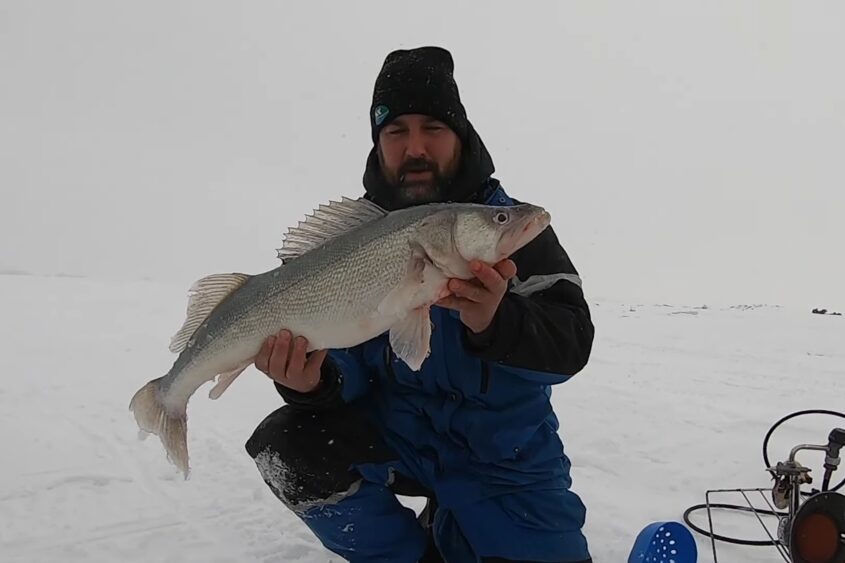
Safety Tips for Lake Winnipeg ice fishing
• Dress appropriately for the weather: The weather in Manitoba can change quickly, so be prepared for any conditions. Dress in layers so you can take off or add clothing to suit the temperature. Wear a hat and gloves to keep your head and hands warm. Always wear a life jacket when on the ice. Bring a portable shelter to keep you dry and warm if you are fishing on the ice. Bring plenty of food and drinks and extra clothing if needed.
• Be careful on the ice: The fishing season on Lake Winnipeg starts when the ice is thick enough to support a person’s weight. The Manitoba government recommends that people not walk or drive on the ice until it is at least 15 cm (6 inches) thick. Lake Winnipeg has many hazards, such as pressure ridges and open water areas that are not always visible from the shore. Stay away from these areas and check the ice conditions before venturing out.
• Don’t fish alone: Take one or two friends with you, and let someone know where you are going.
• Check the weather: The wind can make walking on thin ice very difficult, so it is essential to check the weather before heading out onto Lake Winnipeg.
• Wear a life jacket: Wear a personal flotation device (PFD) designed for ice fishing, or have someone throw you an emergency flotation device if you fall.
Mastering Ice Fishing Techniques for Lake Winnipeg
Armed with an in-depth understanding of Lake Winnipeg’s icy landscape and its prime fishing spots, you’re halfway to ensuring a fruitful fishing trip. Now, it’s time to grasp the techniques that separate the novices from the experts. Whether it’s the ability to effectively sickle a jigging rod or deploying a tip-up setup, mastering these skills is key to outsmarting the canny walleye.
Jigging Techniques
Jigging, the act of moving your lure up and down in the water column, is a tried-and-tested technique for ice fishing. The technique effectively mimics the antics of a wounded baitfish, piquing the interest of the predatory walleye. But remember, each rod movement should be intentional, a strategic play to lure the walleye. Going too fast might scare them away, too slow and they could lose interest. Striking that perfect rhythm is what counts.
Setting up Tip-ups
Tip-ups offer a hands-off approach to fishing whilst increasing the area you can cover at any time. Setting up these contraptions at multiple drilled holes means you can sit back at your base camp, a mug of hot cocoa in hand, while still fishing. And when a fish does bite, the flag on the tip-up jumps to life, signaling an opportunity for a catch. The ease of using tip-ups doesn’t mean you should shirk from regularly checking them – one never knows when a clever walleye outsmarts the device!
Adapting to Altering Conditions
Lake Winnipeg is a live entity with changing moods and shifting underwater scenes. Being adaptable and making alterations to your fishing tactics in response to these changes significantly enhances your chances of a successful catch. Adjust your lure size, color, or even jigging techniques in response to observed fish behavior, and you’ll often find that change is excellent.
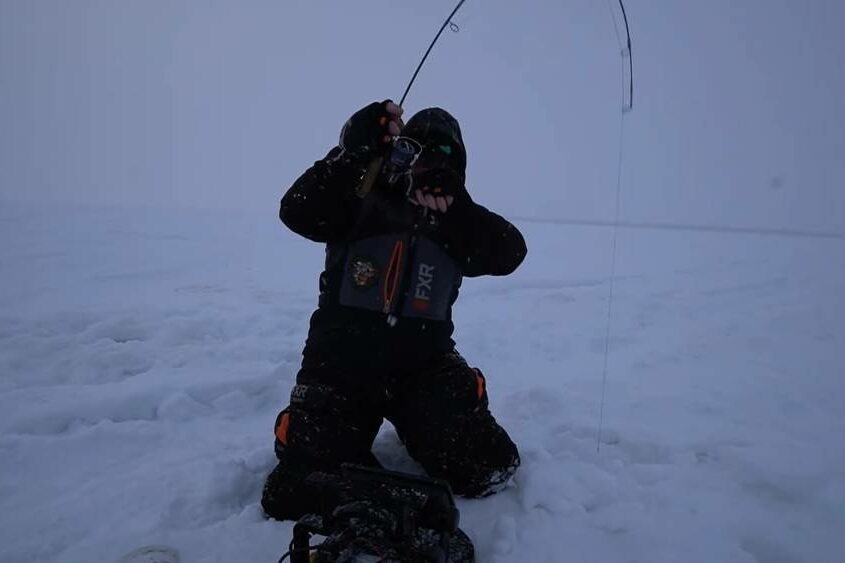
FAQ
How many Walleye can you keep on Lake Winnipeg?
The regulations for walleye fishing on Lake Winnipeg vary depending on the season. During the ice fishing season (December 1 to the last day of February), anglers are allowed to keep a daily limit of four Walleye, with a possession limit of eight. During the open water fishing season (May 15 to the last day of February), the daily limit is reduced to two Walleye, with a possession limit of four. It’s important to note that these regulations are subject to change, and it’s always a good idea to check with local authorities or consult the most up-to-date fishing regulations before heading out on the water.
What is the biggest Walleye ever caught in Lake Winnipeg?
Lake Winnipeg is known for its big Walleye, and there have been many impressive catches over the years. The largest Walleye ever caught on Lake Winnipeg was a massive 16.2 kg (35.7 lbs) fish caught by angler Alameda Klymchuk in 1960. This record-setting catch held for many years until it was finally surpassed in 1988 by a 17.2 kg (38 lbs) walleye caught on the North Saskatchewan River in Saskatchewan. Despite this, Lake Winnipeg remains one of the best destinations for walleye fishing, and anglers continue to flock to the lake in search of their own trophy catch.
How thick is the ice on Lake Winnipeg?
The ice thickness on Lake Winnipeg varies depending on the time of year and location on the lake. Generally, ice fishing on the lake begins mid to late December and continues through February or March, depending on the weather conditions. At the start of the ice fishing season, the ice thickness can be around 15 to 20 centimeters (6 to 8 inches). However, the ice can be much thicker by mid-season, often reaching 60 centimeters (2 feet) or more in some areas. It’s important to note that ice thickness can vary greatly even within the same area of the lake, and it’s essential to always check the ice conditions before venturing onto the ice. It’s also a good idea to carry safety equipment such as ice picks, a rope, and a personal flotation device and to fish with a partner or in a group.
Is it safe to ice fish on Lake Winnipeg?
Ice fishing on Lake Winnipeg can be a safe and enjoyable experience, but it’s important to take the necessary precautions to ensure your safety. One of the most significant risks associated with ice fishing on Lake Winnipeg is the possibility of falling through the ice, which can be life-threatening. To reduce this risk, it’s essential to check the ice conditions before venturing out onto the lake and to always carry safety equipment such as ice picks, a rope, and a personal flotation device.
It’s also a good idea to fish with a partner or in a group, as this can help in case of an emergency. In addition to the risk of falling through the ice, the weather conditions on Lake Winnipeg can be harsh, with strong winds and extreme cold temperatures. It’s important to dress warmly and in layers, wear appropriate footwear, and bring plenty of food and water to stay hydrated. If you’re new to ice fishing, it’s recommended that you go with an experienced guide or outfitter who can show you the ropes and help you stay safe on the ice. By taking these precautions and being aware of the risks, ice fishing on Lake Winnipeg can be a safe and enjoyable experience.

